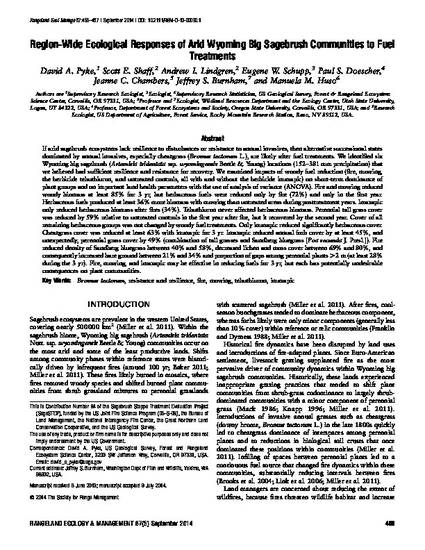
Article
Region-Wide Ecological Responses of Arid Wyoming Big Sagebrush Communities to Fuel Treatments
Rangeland Ecology & Management
(2014)
Abstract
If arid sagebrush ecosystems lack resilience to disturbances or resistance to annual invasives, then alternative successional states dominated by annual invasives, especially cheatgrass (Bromus tectorum L.), are likely after fuel treatments. We identified six Wyoming big sagebrush (Artemisia tridentata ssp. wyomingensis Beetle & Young) locations (152–381 mm precipitation) that we believed had sufficient resilience and resistance for recovery. We examined impacts of woody fuel reduction (fire, mowing, the herbicide tebuthiuron, and untreated controls, all with and without the herbicide imazapic) on short-term dominance of plant groups and on important land health parameters with the use of analysis of variance (ANOVA). Fire and mowing reduced woody biomass at least 85% for 3 yr, but herbaceous fuels were reduced only by fire (72%) and only in the first year. Herbaceous fuels produced at least 36% more biomass with mowing than untreated areas during posttreatment years. Imazapic only reduced herbaceous biomass after fires (34%). Tebuthiuron never affected herbaceous biomass. Perennial tall grass cover was reduced by 59% relative to untreated controls in the first year after fire, but it recovered by the second year...
Disciplines
Publication Date
2014
DOI
https://doi.org/10.2111/REM-D-13-00090.1
Citation Information
Eugene W. Schupp. "Region-Wide Ecological Responses of Arid Wyoming Big Sagebrush Communities to Fuel Treatments" Rangeland Ecology & Management Vol. 67 Iss. 5 (2014) p. 455 - 467 Available at: http://works.bepress.com/eugene_schupp/131/
